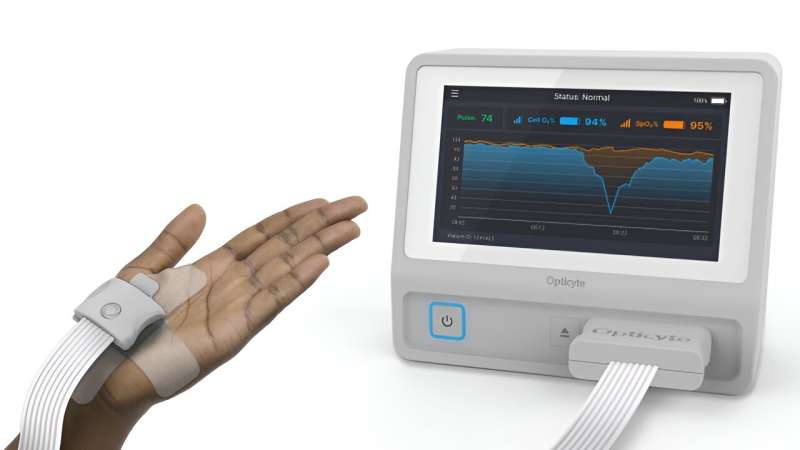This article has been reviewed according to Science X's editorial process and policies. Editors have highlighted the following attributes while ensuring the content's credibility:
fact-checked
trusted source
proofread
Shining light on sepsis: Novel device could allow early detection of deadly condition

Each year, at least 1.7 million adults in the United States and millions more worldwide develop sepsis, a life-threatening condition that occurs when the body's immune system has an extreme response to an infection. The condition, which can be difficult to detect and treat, rapidly damages tissues and vital organs and is one of the leading causes of death in hospitals.
To help doctors spot when the condition may be developing, one medical technology company, Opticyte, has developed a novel, noninvasive device that can send out alerts when a patient has low cell oxygen levels—an early sign of sepsis. The doctor can then treat the patient, often with antibiotics and intravenous fluids, to try to stave off the most severe symptoms of the fast-morphing condition.
Lori Arakaki, Ph.D., the inventor of the technology, called VitalO2, and founder and chief executive officer of Opticyte, called the device a potential gamechanger, and for good reason: It is the first and only cell oxygen monitor that can measure low oxygen levels inside cells in real time.
"The VitalO2 device is easy to use and has the potential to provide clinicians with definitive real-time information needed to prevent multi-organ failure," said Arakaki, a bioengineer by training.
The device includes the monitor, a fiber optic cable for light transmission, and a skin patch that is attached to the patient's palm. The monitor shines light through the cable and into the skin and measures the reflected light. A machine learning algorithm analyzes the reflected light to produce real-time cell oxygen measurements from the patient's muscle tissue. Low oxygen levels in the muscle tissue correlate to low oxygen levels in the cells of the vital organs when the oxygen deficiency is systemic or in the bloodstream.
Currently, the device is also showing promise in monitoring low oxygen levels during trauma, heart failure, and other conditions.
"In the future, I anticipate that VitalO2 will be widely used in emergency rooms, ICUs, surgical suites, nursing homes, ambulances, and other settings where there's a need for quick, accurate cellular oxygen measurements," Arakaki said.
Thus far, the prototype device has been tested in a first-in-human observational sepsis study of about 150 patients at two medical centers in Seattle. Additional studies using the VitalO2 device to predict organ dysfunction and death in patients with sepsis are likely next. Opticyte also has ongoing studies with encouraging initial results for improving red blood cell transfusion decisions in cancer patients and for recognizing shock in heart surgery patients.
Blood oxygen levels are currently measured with a device called a pulse oximeter, which is placed at the end of a finger and works by using beams of light. However, this decades-old technology only measures oxygen saturation in arterial blood, not at the cellular or tissue level. The problem is that in sepsis and other severe conditions, patients often show normal blood oxygen levels on oximeter readings, even when insufficient oxygen is present in the cells and tissues. As a result, pulse oximeters can easily miss early signs of systemic oxygen deficiency associated with sepsis, hemorrhage, and heart failure—all situations that can quickly result in organ failure and death.
Studies have shown that pulse oximeters have a higher error rate for measuring blood oxygen levels in Black patients. Importantly, Opticyte's VitalO2 device has been engineered and tested from the start to be accurate in people with different skin tones or pigmentation levels ranging from light to dark, reducing the chance of measurement errors in patients, Arakaki said. The device's algorithm was also engineered to be sensitive to different sexes and body weights.
"This device will fill a longstanding medical need, especially in the emergency medicine and critical care communities," Arakaki said. "There are so many ways that people can develop deficient systemic oxygenation leading to organ failure."
In 2023, Opticyte's product received Breakthrough Device Designation from the U.S. Food and Drug Administration. Arakaki believes that will speed up the review process and lead to FDA clearance within the next one to two years.
Stephanie M. Davis, Ph.D., coordinator of NHLBI's Small Business Program, said in the meantime that her team looks forward to the results of further testing.
"This is a novel device that has the potential to save lives," she said. "It could one day help reduce the high number of deaths from sepsis in hospitals and help monitor oxygen depletion in other serious medical conditions, including heart disease."

















